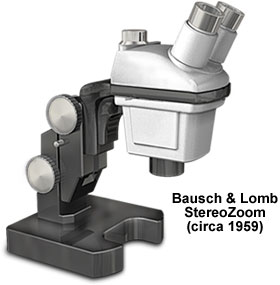Bausch & Lomb StereoZoom Binocular Stereomicroscope
In 1959, Bausch & Lomb introduced an innovative stereomicroscope that was equipped with continuously variable, or zoom, magnification. Inspired by the basic Greenough design, this instrument, which was dubbed the StereoZoom, was the first commercial stereomicroscope devoid of erecting prisms.

The StereoZoom was generally the same size and shape as its primary competitor, the American Optical Cycloptic. Both instruments had a magnification range of 0.7x to 3.0x and comparable working distances. The StereoZoom, however, could be differentiated by its inclusion of a new Bausch & Lomb development: four first-surface mirrors with enhanced aluminum coatings, which were situated in a manner that enabled them to execute the functions of inclination prisms and Porro erecting prisms. The novel design facilitated erect images, and a specimen viewed through its eyepieces had the same physical orientation as it did on the on the microscope stage. The effect was particularly useful in stereomicroscopy because microscopists are often obliged to perform interactive manipulations on specimen while under examination. Activities such as dissection, industrial assembly, and microinjection can be more conveniently conducted when the microscopic images viewed are erect.
Since the StereoZoom did not contain prisms, the instrument was produced and sold for a lower cost than many other microscopes, and was also lighter in weight. The basic microscope system was called the Power Pod and could be supplemented by an enormous array of auxiliary lenses, eyepieces, illuminators, arms, and stands. The microscope and its complementing products were fashionably designed in a style that endured for more than 40 years. A rapid emergence of the semiconductor industry in the 1980s, which quickly adopted the use of the StereoZoom, further helped ensure the instrument's success and long-lived use. The unique design continuously dominated the stereomicroscope market until its production was finally halted in 2000.
BACK TO TWENTIETH CENTURY BAUSCH & LOMB MICROSCOPES
BACK TO TWENTIETH CENTURY MICROSCOPES
